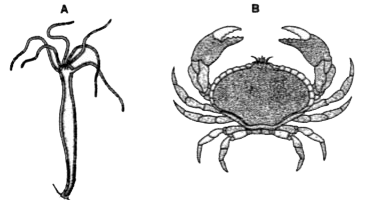Enumerate the following characters in the animals :
(i) Symmetry
(ii) Body temparature.
Step-by-Step Solution
1. Symmetry in Animals:
- Symmetry refers to the balanced proportions of an organism's body. There are three main types of symmetry observed in animals:
- Asymmetrical: These animals do not exhibit any symmetry. No matter how you cut them, they cannot be divided into equal halves. An example of asymmetrical animals is found in the phylum Porifera (sponges).
- Bilateral Symmetry: Animals with bilateral symmetry can be divided into two equal halves along a single plane. This means that if you draw a line down the middle, both sides will be mirror images of each other. An example of bilaterally symmetrical organisms includes members of the phylum Arthropoda (insects, arachnids, crustaceans).
- Radial Symmetry: In this type, animals can be divided into similar halves by multiple planes passing through a central axis. This means that no matter how you slice it, the halves will be equal. An example of animals with radial symmetry is found in the phylum Echinodermata (starfish, sea urchins).
2. Body Temperature in Animals:
- Body temperature regulation varies among animals and can be classified into two main categories:
- Poikilotherms: These are commonly known as cold-blooded animals. They cannot regulate their body temperature internally and instead rely on external environmental conditions to determine their body temperature. Examples include amphibians (like frogs) and reptiles (like lizards).
- Homeotherms: These are warm-blooded animals that maintain a constant body temperature regardless of external conditions. They can regulate their internal temperature through metabolic processes. Examples of homeothermic animals include mammals (like humans) and birds (like sparrows).
Summary
- Symmetry Types:
- Asymmetrical (e.g., Porifera)
- Bilateral Symmetry (e.g., Arthropoda)
- Radial Symmetry (e.g., Echinodermata)
- Body Temperature Types:
- Poikilotherms (e.g., amphibians, reptiles)
- Homeotherms (e.g., mammals, birds)
- Symmetry refers to the balanced proportions of an organism's body. There are three main types of symmetry observed in animals:
- Asymmetrical: These animals do not exhibit any symmetry. No matter how you cut them, they cannot be divided into equal halves. An example of asymmetrical animals is found in the phylum Porifera (sponges).
- Bilateral Symmetry: Animals with bilateral symmetry can be divided into two equal halves along a single plane. This means that if you draw a line down the middle, both sides will be mirror images of each other. An example of bilaterally symmetrical organisms includes members of the phylum Arthropoda (insects, arachnids, crustaceans).
- Radial Symmetry: In this type, animals can be divided into similar halves by multiple planes passing through a central axis. This means that no matter how you slice it, the halves will be equal. An example of animals with radial symmetry is found in the phylum Echinodermata (starfish, sea urchins).
- Body temperature regulation varies among animals and can be classified into two main categories:
- Poikilotherms: These are commonly known as cold-blooded animals. They cannot regulate their body temperature internally and instead rely on external environmental conditions to determine their body temperature. Examples include amphibians (like frogs) and reptiles (like lizards).
- Homeotherms: These are warm-blooded animals that maintain a constant body temperature regardless of external conditions. They can regulate their internal temperature through metabolic processes. Examples of homeothermic animals include mammals (like humans) and birds (like sparrows).
- Symmetry Types:
- Asymmetrical (e.g., Porifera)
- Bilateral Symmetry (e.g., Arthropoda)
- Radial Symmetry (e.g., Echinodermata)
- Poikilotherms (e.g., amphibians, reptiles)
- Homeotherms (e.g., mammals, birds)
Topper's Solved these Questions
- ANIMAL KINGDOMBOOK - MODERN PUBLICATIONCHAPTER - ANIMAL KINGDOMEXERCISE - QUICK MEMORY TEST (TRUE AND FALSE)
25 Videos
- ANIMAL KINGDOMBOOK - MODERN PUBLICATIONCHAPTER - ANIMAL KINGDOMEXERCISE - QUICK MEMORY TEST (COMPLETE THE MISSING LINKS)
35 Videos
- ANIMAL KINGDOMBOOK - MODERN PUBLICATIONCHAPTER - ANIMAL KINGDOMEXERCISE - HIGHER ORDER THINKING SKILLS (SHORT ANSWER QUESTIONS)
14 Videos
- ANATOMY OF FLOWERING PLANTS BOOK - MODERN PUBLICATIONCHAPTER - ANATOMY OF FLOWERING PLANTS EXERCISE - Chapter Practice Test
10 Videos
- BIOLOGICAL CLASSIFICATIONBOOK - MODERN PUBLICATIONCHAPTER - BIOLOGICAL CLASSIFICATIONEXERCISE - CHAPTER PRACTICE TEST
16 Videos
Similar Questions
Identify the incorrect match of animal and its symmetry?
View SolutionYou have discovered an animal having characters like, triploblastic, bilateral symmetry, coelomate, chitinous exoskeleton, head, thorax and abdomen as bidy parts, and jointed appendages.
You should place the animal under
View Solution
Knowledge Check
An aclomate animals with bilateral symmetry is
AHydraBLiver flukeCPhysaliaDObeliaAnimal A and B show symmetry -
 ABilateral, Asymmetrical respecitvelyBRadial, Bilateral respecitvelyCBilaterai, Bilateral respecitvelyDRadial, Radial respecitvely
ABilateral, Asymmetrical respecitvelyBRadial, Bilateral respecitvelyCBilaterai, Bilateral respecitvelyDRadial, Radial respecitvelyCharacters of both animals and plants are found in
AVirusesBBacteriaCEuglenaDMycoplasma
What are the following terms referred to as ?
(i) Auroral animals (ii) Vesperal animals.
View SolutionWhich one of the following has a bilateral symmetry in its body organization?
View SolutionAn acoelomate animal with bilateral symmetry is
View SolutionAn acoelomate animal with bilateral symmetry is
View SolutionArrange the following words as per order in the dictionary :
(i) Ambitious
(ii) Ambiguous
(iii) Ambiguity
(iv) Animation
(v) Animals
View Solution
